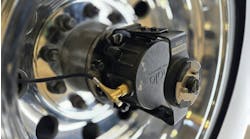Remote diagnostics offers fleets the capability to monitor a vehicle in real time as it is on the road. Fault codes, along with other vehicle information, can be recorded and transmitted to the appropriate parties in order to inform fleet managers, maintenance managers, and technicians of vehicle data, status, and events. With diagnostic information being transmitted in real time, fleets can work in tandem with remote diagnostics providers to decide the best course of action for that vehicle and, in turn, expedite the diagnostic process before the vehicle pulls into the bay.
Data from a distance
“In its simplest form, remote diagnostics means having the ability to receive real-time diagnostic data from the vehicle without being in its vicinity,” says Scott Bolt, vice president of product management, Noregon. “Effective remote diagnostics give the user the tools to diagnose the truck rather than a stream of SAE fault data. Remote diagnostic applications should describe the vehicle’s state in simple terms and provide actionable plans because there is a far greater chance the user does not have a comprehensive maintenance background compared to those using in-shop tools.”
Bolt adds that remote diagnostic tools should offer enhanced OE-level fault codes, effect-on-vehicle descriptions, action plans for managing the vehicle based on its current state, and bidirectional tools to correct problems and avoid costly tow jobs or mobile repairs that lead to avoidable downtime.
In order to effectively diagnose a vehicle remotely, sufficient data and information must be provided across all accessible systems on the vehicle.
“The information that is programmed can be extracted,” says Bruno Gattamorta, vice president of sales and marketing, Cojali USA. “Since there are thousands and thousands of data inputs, you can program the most relevant and then extract the rest at a later time. Anything that goes on the CAN lines or is governed by an ECM can be extracted, and in our case, modified.”
The live data, load capacity, consumption, speed, throttle level, and more can be monitored, Gattamorta says. If the truck measures it, it can be extracted via telematics.
Beyond monitoring systems and diagnosing issues, a remote diagnostics integration can also help fleets manage operations. Insight into vehicle performance provided through a remote diagnostic and telematic solution can lead to improving safety, decreasing liability, and optimizing fuel economy, Bolt says.
Remote diagnostic systems come in many shapes and sizes, from OE integrations to aftermarket options. Understanding what different remote diagnostic systems have to offer and how they provide such offerings can help fleets navigate the decision-making process of how to best implement remote diagnostics into their operations and which option is best suited for their needs.
One example of an OE remote diagnostic solution is Mack Trucks’ Mack GuardDog Connect.
“Mack GuardDog Connect hardware is comprised of our proprietary telematics gateway and hundreds of sensors located throughout the truck working together to monitor data from each truck for fault codes that are triggered when something goes wrong with one of a vehicle’s major systems, such as the engine or transmission,” says David Pardue, vice president of connected vehicle and contract services, Mack Trucks. “The gateway is designed to access the core data networks within the trucks in order to reliably collect and store data without interfering with truck operations. The sensors collect streaming IoT data, including where a particular mechanical event happened and what conditions were present during the fault, such as altitude, ambient air temperature, rpm level, and torque load to give the information context for diagnosis.”
Having a vehicle manufacturer offer a remote diagnostic integration brings with it the advantage of total system understanding and simplifies the decision-making process when choosing a provider for fleets that run one manufacturer type.
“Mack uses software from SAS to apply complex and analytical-based rules,” Pardue continues. “If an issue is detected, the software creates support cases and sends them to an outbound message queue. Mack uses the ASIST system, a web-based service management platform, to pick up messages from that outbound message queue to process customer notifications. Customers are then notified of faults by a Mack Trucks Uptime Center employee based on their preference for email, text, and/or phone notifications.”
Information dissemination
The way in which the information gathered from remote diagnostic systems is relayed and displayed is just as crucial as the information itself. Presentation is everything, and the ability to tailor that data to the needs of a fleet operation can make all the difference in successful utilization of remote diagnostics.
“Remote diagnostic software is typically a web portal or mobile application,” Bolt says. “The portal should offer high-level information from a dashboard view so the total health of a fleet can quickly be discerned in a glance, but offer advanced capabilities to drill into issues on individual vehicles to pass along to maintenance professionals.”
“There is a fine line between overwhelming the user with too much data and not offering enough information to make actionable decisions,” Bolt advises. “This signifies the importance of a customizable system that the fleet can configure to their needs … One of the great aspects of remote diagnostics is managing who receives which bits of information. For example, a maintenance manager can be set up to receive comprehensive diagnostic information when trucks reach a certain severity level, while dispatchers are made aware of actionable faults, which are faults that the driver can address through actions such as adding coolant.”
Remote diagnostics systems such as Noregon’s TripVision Uptime offer fleets the flexibility to be alerted to certain parameters of their choosing, such as when a truck registers a fault code that affects fuel economy, Bolt explains. These parameters can be fine-tuned according to a fleet’s operation across all vehicles, or to specific vehicles and routes.
“For Jaltest Telematics, what you get is a user portal where you can filter by vehicles, features, and functionalities,” Gattamorta says. “The goal is to have a holistic approach with insights from customers [on pick up and deliveries], from the technicians [based on maintenance data], and the fleet manager [via geofence, driver behavior, GPS tracking, et cetera]. When you enter the platform, you can use one vehicle or run driver behavior comparisons, load distinction, harsh braking metrics, et cetera. Guiding drivers through their metrics gives great insight on consumption.”
Actionable insight
When a fleet decides which information is most pertinent to their operations, and the manner in which they prefer its delivery, the next determination is how this remote diagnostic information can be best utilized to maximize uptime and improve operational efficiencies.
“After identifying an issue, Mack GuardDog Connect has the ability to let customers know if it’s a critical fault that could potentially shut a truck down, or if it’s something more minor that can be addressed at a later date,” Pardue says. “In addition, the system does confirm parts availability, as well as dealer service by space, all while the customer’s truck is still on the road.”
Bolt relays that Noregon considered users of remote diagnostic tools may not have extensive maintenance backgrounds, and so designed TripVision Uptime to “feel like there is a master mechanic monitoring all of your trucks.” When an issue is detected, information presented as “action plans” is delivered and explains the best way to handle the truck in its current state. This could be notifications to pull over before extensive damage occurs or coordinating diagnostic information with a shop to initiate a triage before the vehicle arrives on site.
“One of the latest technologies we added to TripVision Uptime is predictive health,” Bolt says. “We can alert users [to conditions] that are likely to escalate into a serious problem, give time and mileage estimates for when the failure would occur, as well as the relative likelihood that the failure will happen. With this information, customers can schedule maintenance for an issue that has not yet occurred but could lead to a breakdown or more costly repair if not addressed.”
Remote diagnostics are the forefront of total insight into operations and performance. Fleets have the ability to integrate such systems into their vehicles in order to capture real-time data without having an asset parked in a service bay. Utilizing the insightful data provided through remote diagnostics offers the ability for fleets to stay ahead of impending failures, accurately and timely unveil performance issues, and furthermore optimize efficiencies and uptime.




